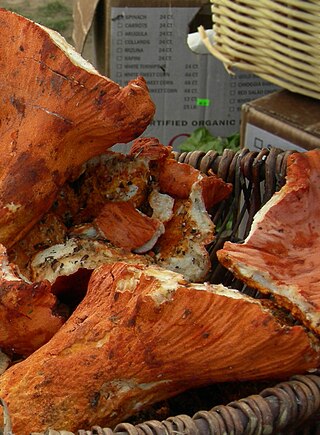
Hypomyces lactifluorum, the lobster mushroom, contrary to its common name, is neither a mushroom nor a crustacean, but rather a parasitic ascomycete fungus that grows on certain species of mushrooms, turning them a reddish orange color that resembles the outer shell of a cooked lobster. H. lactifluorum specifically attacks members of the genera Lactarius and Lactifluus (milk-caps), and Russula (brittlegills), such as Russula brevipes and Lactifluus piperatus in North America. At maturity, H. lactifluorum thoroughly covers its host, rendering it unidentifiable. Lobster mushrooms are widely eaten and enjoyed freshly foraged and cooked. They are commercially marketed and sometimes found in grocery stores; they have been made available at markets in Oregon. They have a seafood-like flavor and a firm, dense texture.

Helvella crispa, also known as the white saddle, elfin saddle or common helvel, is an ascomycete fungus of the family Helvellaceae. The mushroom is readily identified by its irregularly shaped whitish cap, fluted stem, and fuzzy undersurfaces. It is found in eastern North America and in Europe, near deciduous trees in summer and autumn.

Hypomyces is a genus of parasitic ascomycete fungi found in Europe, North America, Australia, and parts of China. The genus contains 53 species. Better known species include the lobster mushroom and the bolete eater.

Gyromitra gigas, commonly known as the giants false morel, snow morel, snow false morel, calf brain, or bull nose, is a fungus and a member of the Ascomycota found in Europe. It is referred to as one of the false morels, due to its similar appearance and occurrence in the spring and early summer in similar habitats to true morels.

Sarcoscypha coccinea, commonly known as the scarlet elf cup, scarlet elf cap, or the scarlet cup, is a species of fungus in the family Sarcoscyphaceae of the order Pezizales. The fungus, widely distributed in the Northern Hemisphere, has been found in Africa, Asia, Europe, North and South America, and Australia. The type species of the genus Sarcoscypha, S. coccinea has been known by many names since its first appearance in the scientific literature in 1772. Phylogenetic analysis shows the species to be most closely related to other Sarcoscypha species that contain numerous small oil droplets in their spores, such as the North Atlantic island species S. macaronesica. Due to similar physical appearances and sometimes overlapping distributions, S. coccinea has often been confused with S. occidentalis, S. austriaca, and S. dudleyi.

Gyromitra infula, commonly known as the hooded false morel or the elfin saddle, is a fungus in the family Helvellaceae. The dark reddish-brown caps of the fruit bodies develop a characteristic saddle-shape in maturity, and the ends of both saddle lobes are drawn out to sharp tips that project above the level of the fruit body. The stipe is white or flushed pale brown, smooth on the outside, but hollow with some chambers inside. It is found in the Northern Hemisphere, usually in the late summer and autumn, growing on rotting wood or on hard packed ground. G. infula is considered inedible as it contains the toxic compound gyromitrin which, when metabolized by the body, is converted into monomethylhydrazine, a component of some rocket fuels. The toxin may be removed by thorough cooking. Gyromitra fungi are included in the informal category "false morels".

Helvella is a genus of ascomycete fungus of the family Helvellaceae. The mushrooms, commonly known as elfin saddles, are identified by their irregularly shaped caps, fluted stems, and fuzzy undersurfaces. They are found in North America and in Europe. Well known species include the whitish H. crispa and the grey H. lacunosa. They have been reported to cause gastrointestinal symptoms when eaten raw.
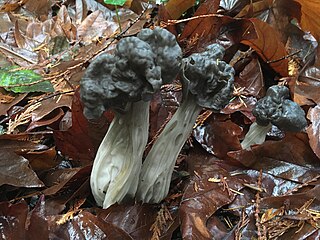
Helvella lacunosa, known as the slate grey saddle or fluted black elfin saddle in North America, simply as the elfin saddle in Britain, is an ascomycete fungus of the family Helvellaceae. It is one of the most common species in the genus Helvella. The mushroom is readily identified by its irregularly shaped grey cap, fluted stem, and fuzzy undersurfaces. It is usually found in Eastern North America and in Europe, near deciduous and coniferous trees in summer and autumn.

Gomphus clavatus, commonly known as pig's ears or the violet chanterelle, is an edible species of fungus in the genus Gomphus native to Eurasia and North America. The fruit body is vase- or fan-shaped with wavy edges to its rim, and grows up to 15–16 cm wide and 17 cm tall. The upper surface or cap is orangish-brown to lilac, while the lower spore-bearing surface, the hymenium, is covered in wrinkles and ridges rather than gills or pores, and is a distinctive purple color. Described by Jacob Christian Schäffer in 1774, G. clavatus has had several name changes and many alternative scientific names, having been classified in the genus Cantharellus, though it is not closely related to them.

Helvella acetabulum is a species of fungus in the family Helvellaceae, order Pezizales. This relatively large cup-shaped fungus is characterized by a tan fruit body with prominent branching ribs resembling a cabbage leaf; for this reason it is commonly known as the cabbage leaf Helvella. Other colloquial names include the vinegar cup and the brown ribbed elfin cup. The fruit bodies reaches dimensions of 8 cm (3.1 in) by 4 cm (1.6 in) tall. It is found in Asia, Europe, and North America, where it grows in sandy soils, under both coniferous and deciduous trees.
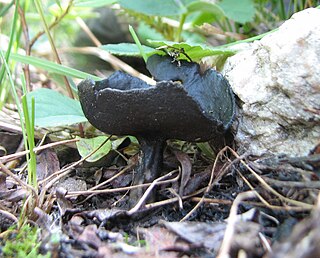
Helvella corium is a species of fungus in the family Helvellaceae of the order Pezizales. This inedible cup-shaped fungus is black, and grows on the ground often near willows in deciduous or mixed forests.
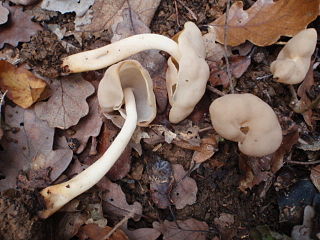
Helvella elastica, commonly known as the flexible Helvella, or the elastic saddle, is a species of fungus in the family Helvellaceae of the order Pezizales. It is found in Asia, Europe, and North America. It has a roughly saddle-shaped yellow-brown cap atop a whitish stipe, and grows on soil in woods. Another colloquial name is the brown elfin saddle.

Dissingia leucomelaena, commonly known as the white-footed elf cup, is a species of fungus in the family Helvellaceae of the order Pezizales. As its common name implies, it is characterized by the white coloring of its stem.

Helvella macropus is a species of fungus in the family Helvellaceae of the order Pezizales. Ascocarps are found in summer and autumn in woodland, usually associated with broad-leaved trees.
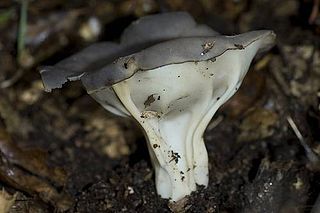
Helvella costifera is a species of fungus in the family Helvellaceae, Pezizales order. Its ascocarp has conspicuous ribs on its undersurface.
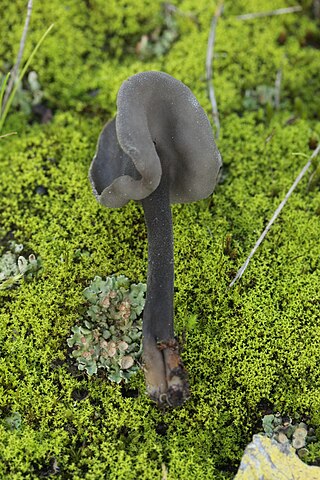
Helvella atra is a species of fungus in the family Helvellaceae of the order Pezizales.

Plectania nannfeldtii, commonly known as Nannfeldt's Plectania, the black felt cup, or the black snowbank cup fungus, is a species of fungus in the family Sarcosomataceae. The fruit bodies of this species resemble small, black, goblet-shaped shallow cups up to 3 cm wide, with stems up to 4 cm long attached to black mycelia. Fruit bodies, which may appear alone or in groups on the ground in conifer duff, are usually attached to buried woody debris, and are commonly associated with melting snow. Plectania nannfeldtii is found in western North America and in Asia, often at higher elevations. Similar black cup fungi with which P. nannfeldtii may be confused include Pseudoplectania vogesiaca, P. nigrella, and Helvella corium.

Leotia lubrica, commonly referred to as a jelly baby, is a species of fungus in the family Leotiaceae. The species produces small fruit bodies up to 6 centimetres (2.4 in) in height, featuring a "head" and a stalk. Ochre with tints of olive-green, the heads are irregularly shaped, while the stalk, of a similar colour, attaches them to the ground. The appearance can be somewhat variable and is similar to a number of other species, including Cudonia confusa, C. circinans, L. atrovirens and L. viscosa. L. lubrica was first validly described by Giovanni Antonio Scopoli, but it was later transferred to Leotia by Christiaan Hendrik Persoon. Its relationship with other members of the genus, of which it is the type species, is complicated.

Hypomyces cervinigenus is a parasitic ascomycete fungus that grows on elfin saddle (Helvella) mushrooms in Europe and North America.
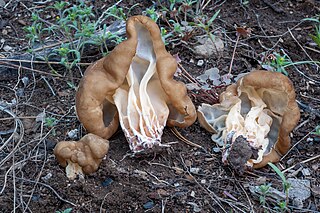
Gyromitra californica is a species of fungus in the family Discinaceae. It was described as Helvella californica by W. Phillips in 1879. It is considered probably poisonous.



















